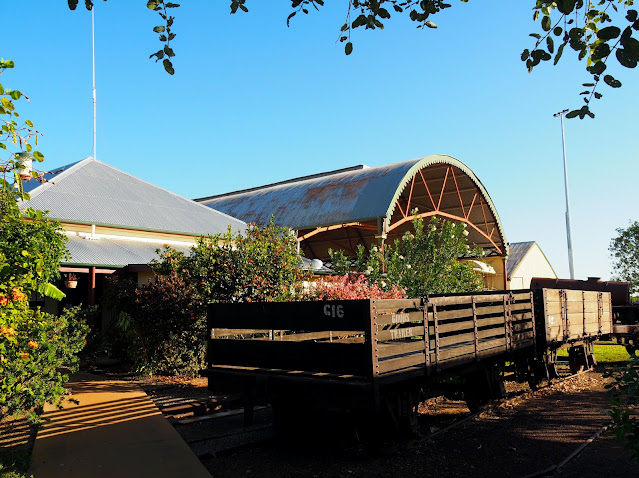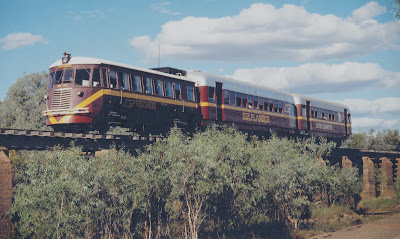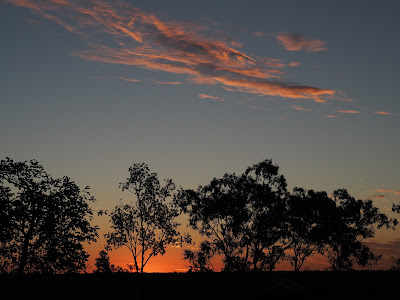Established in the late 1860s, Normanton, on the Norman River in the Shire of Carpentaria, is like a town suspended in time. Its boom years were tied to the discovery of gold on the Croydon goldfields, beginning in 1885. My great-grandmother, Emily, was born in Normanton in 1892, and her mother, Minnie, (along with Minnie's siblings Louisa and William) had been among the first prospective students at the Normanton School. I wanted to visit Normanton to see the place where Emily (and her mother) had grown up.
 |
| Side view of the Railway Station at Normanton, with steel framed Carriage Shade at rear. Photo: Trisha Fielding 2021. |
The journey from Croydon to Normanton was an easy 151km drive, with two lanes of bitumen all the way to Normanton. We arrived late morning and stopped at a small park with a quaint-looking QCWA hall in the centre of a lovely patch of green grass. A tiny oasis in a parched landscape. Home to around 1200 people, Normanton sits on an ironstone ridge, surrounded by savannah grasslands and tidal saltpans. Though dry and dusty at the time of year we visited (September), during the wet season, the landscape around Normanton morphs into a spectacular wetland, teeming with wildlife.
 |
| The landscape around Normanton. Photo: Trisha Fielding 2021. |
My first impression of Normanton was that it seemed to have a sort of forgotten feel about it - as though it's somehow still suspended in the middle of last century. The wide streets were mostly empty of people, but perhaps the locals have more sense than to be out sightseeing in the middle of the day? Highlights, in terms of heritage buildings, include the former Bank of New South Wales, the iconic Purple Pub (formerly known as the National Hotel), the Carpentaria Shire Building, the old Burns Philp Building, and the Railway Station complex.
 |
| Former Bank of New South Wales, Normanton. Photo: Trisha Fielding 2021. |
 |
| The Purple Pub - originally the National Hotel, Normanton. Photo: Trisha Fielding 2021. |
 |
| Carpentaria Shire Building, Normanton. Photo: Trisha Fielding 2021. |
Situated on the corner of Landsborough and Caroline Streets, the large, timber-framed and metal-clad Burns Philp & Co. building, built in 1884, is a dominant feature of the town, being visible from the air when flying into Normanton. It is a rare surviving example, and the oldest of the company's nineteenth century structures in Queensland which included those in Brisbane, Townsville, Cairns, Bowen, Charters Towers, Burketown, Cooktown and Thursday Island. It operated continuously as a general mercantile store and agency office for more than 120 years. It now houses an information centre and library.
Soon we were thinking about lunch, and we settled on the Albion Hotel. We sat outside under a covered verandah to have our lunch, and although it was a hot day this was pretty comfortable. The food was basic pub fare and the drinks were icy cold - so all up, we were happy.
 |
| Albion Hotel, Normanton, 2021. Photo: Trisha Fielding. |
 |
| Albion Hotel, Normanton, 1953. Photo: State Library of Queensland. |
I asked for (and received) permission from the bar staff to take some photographs of the painted tiles that decorated the top of one wall, close to the ceiling. These tiles (some are pictured below) once adorned the counter-top of the bar, and were illustrated by Percy Trezise, an artist, conservationist, rock art specialist, Aboriginal rights activist, author, bushman, pilot and storyteller.
 |
| Illustrations by Percy Trezise, Albion Hotel, Normanton. Photos: Trisha Fielding 2021. |
Normanton is the terminus for the Normanton to Croydon railway line, and the town's historic Railway Station complex is an absolute must-see. Construction on the Normanton to Croydon line began in 1881, under the supervision of a surveyor named George Phillips. The country around Normanton is sparsely timbered and prone to flooding, so Phillips designed and patented a system which utilised special U-shaped steel sleepers laid directly on the ground. During floods the line could be submerged without washing out the ballast and embankments normally used, so that it could quickly be put back into service when the waters subsided. The steel sleepers were also impervious to termite attack. The line reached Croydon in 1891. Phillips's steel sleepers remain in use to this day.
 |
| Carriage Shade, Normanton Railway Station. Photo: Trisha Fielding 2021. |
Built around 1889, the Station building and Carriage Shade were designed by James Gartside, a draftsman for the Railways Department, and built under Phillips's supervision. At its peak the station building contained a telegraph office, station master and traffic managers offices, clerk's room, parcels and cloak room, booking office, and a ladies room. The curved Carriage Shade sheltered the platform and three tracks.
 |
| The rail-motor known as The Gulflander now runs weekly between Normanton and Croydon. Photo: Tourist Information Board, Normanton. |
I loved experiencing the place where my great-grandmother grew up. Now I can really appreciate (and better understand) why (when she was very old, frail and blind; and staying at my grandparents' house in the 1980s) she kept asking whether we had packed enough water for our trip? This was just a trip in our car to our house - a few suburbs away - but she was concerned we might not have enough water for the journey. A child at the time, I thought it was a funny thing for her to say - but I truly get it now. She was remembering back to her days in Normanton. You wouldn't last long up this way if you set out without water. Not then. And not now, either.
Oh... and one last thing... the sunsets in Normanton are spectacular!
 |
| Sunset, Normanton. Photo: Trisha Fielding 2021. |






I enjoyed your account of Normanton and the life of your grandparents. I am presently researching life for the early pioneers like my mums grandparents who settled in Normanton. They must have endured such hardship in getting to Normanton
ReplyDelete